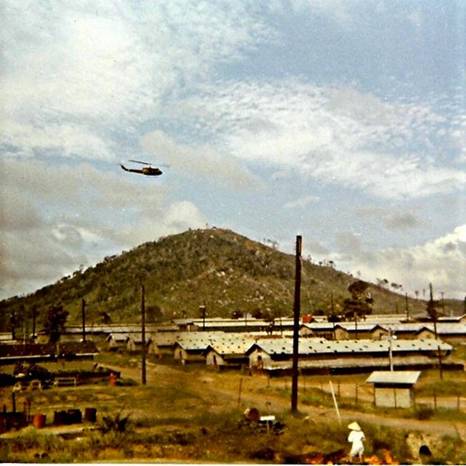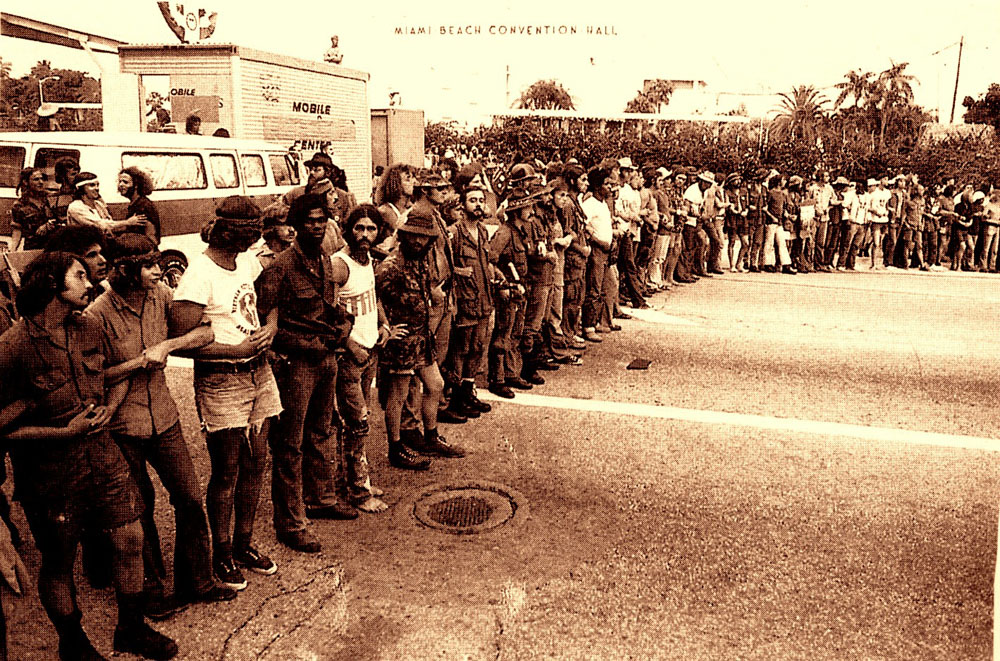 |
Flowers for An LocBy Jim WillinghamIt was the 3rd time the south Vietnamese and American bases at An Loc had been attacked, every two years on that date and time, 9/9/66 and 68, then this morning, 9/9/70. It was consistent with a series of attacks that had been happening on 3 bases in III Corps (N of Saigon), 1 in II Corps (E of Saigon) and 1 in IV Corps (S of Saigon), every 2 years on specific dates, in addition to the annual Tet. This kept the rhythms of the north Vietnamese attacks on these bases pulsing with an ongoing intensity that was increasing on every repeat occasion. Rocket propelled grenades were the weapon of choice against Hueys and Cobras, A-28's and A-37's.
There were no RPG's at An Loc on 9/9/70, because they had all been destroyed in Cambodia across the border 70 km. north, 4 months earlier during the ARVN/American incursion the first 2 weeks of May. The infantry had been drawn back in III Corps, then concentrated NW to Tay Ninh along with some ARVN troops, then another army of infantry went NNE to Song Be and was staged there, 100% ARVN. They were supported by the air cavalry and fighters, with 300 ARVN and American casualties. After this, the infantry was kept drawn back in III Corps. Casualties of Americans and South Vietnamese dropped dramatically. The North Vietnamese combatants with weapons had been centrally located north of III Corps and were fanning out to the SW and S to the SE, going everywhere. The other weapons caches had been NE of Song Be and North Vietnamese combatants had been crossing the border going east into the southern highlands. They were going everywhere from there, east then north to the Pacific highlands, southeast then dropping down to the coast and traveling south on sampans to the mangrove forests in II and IV Corps. Others were attacking Dalat City, or trying unsuccessfully. Still others were making their way across and down into the southeastern forests, where they were repelled by the Americans and South Vietnamese. There had been the potential of larger attacks, first at An Loc on 9/9/70, with a fusillade of RPG's. One man could carry 10 in his belt and 1 in his launcher. 100 men could have carried 1100 RPG's, downed the entire fleet of air cavalry coming in from Bien Hoa, followed by the A-28's and A-37's, with a mass of 8,000 more then able to overrun both bases, killing them all and heading south. There were no RPGs on 9/9/70, only many AK-47's; I shot one man who had a hand grenade and there were 2 light machine guns with clips. They all died, est. 8,000, based on the dimensions and volume of them. I shot 90 times with a .38, 90 hits. I shot one man twice and another man 3 times, because he was still moving and close. I was with 40 ARVN Rangers with M-16's, their Lt. Col. standing by with the rest of my C-7 crew plus the M-60 gunners at the American and ARVN bases, 40 choppers, 15 A-28's, 2 A-37's, artillery and defoliated woods. We lost no one, no one wounded. Unfortunately, I was in that final series of all 5 defensive battles at those bases, by destiny, from An Loc in III Corps on 9/9/70 to Vinh Long in IV Corps on 6/13/71 and three major airborne command post situations from the cockpit of a C-7, calling artillery and air power, with a lot of North Vietnamese dead. I have always grieved a lot about them, along with the two Army men we lost at Katum Artillery Base on 4/3/71 and the 28 Marines we lost at the Vinh Long Navy Swiftboat Base, where it came together with the Army base. I remember them visually, the Army men brave, smiling and proud, the last two Marines rising up together, firing across the river. I fired 5 shots above them across into the woods to let them know we were coming, as we ran down from the Army base. They went down again, together. I fired a 6th shot across, to let the Navy ground troops know we were coming. We had 20 M-16's, including 2 sister soldiers, 1 grenade launcher and 2 .38's. There were about 10 Navy ground troops, including a forward M-60 gunner and a sister manning an M-40 above the Navy base wall. She called for choppers on the land line and kept firing. No one more of us died, no one wounded after that. The North Vietnamese, from the mangrove forests downriver, all died. They were driven, always suicidal with their attacks. There were two surviving elderly Vietnamese from the river village of 25 sampans, 48/50 died. The Marines had been sent out onto the sampans, ordered by their Marine Colonel. He died with them, his body floating face up, head first downriver while the battle raged. After the choppers came, the Navy Corpsmen brought out the two elderly survivors, a woman unhurt physically, but in shock and a man shot in his left shoulder, already packed and bravely walking out with the Navy men. Some of the younger relatives from the village behind the bases came forward greeting them. The man went to the Navy hospital. I had to apologize to them. "Sin loi, Buddhist?" and bow. I prayed over the fallen Marines. I gripped the back left-lower leg of a Marine. He was still warm. I pounded my fist into his calf. He was gone, along with all 27 of them, down on the sampans. The Marines covered the bodies of the small, elderly sampan people as they fell from the sudden massive ambush, coming from a block of tall green trees across the river. That's the one that broke me, an accumulation of violent experiences, beyond the pale. I debriefed the Navy ground troops. I reminded them of the UCMJ, that they had the right to say, "Sir! No, sir!" to avoid irrational orders with reckless endangerment and how to cover for each other in the event an officer points his gun at one of them, which he did.
I remember my 3 mercy killings, a wounded man weeping, sobbing in despair in dark woods north of Lai Khe Army base on 10/17/70. I yelled, "Mercy!" shot for the sound, he was quiet. A small Vietnamese woman was mortally wounded, calling for help. She had a red stain on her black shirt, below her left breast. A man was writhing in pain at Katum on 4/3/71. The bullets were flying. I called to the woman, loudly, "You're precious! I love you!" and to the man, "Mercy!" before I shot them. We had to keep firing. There were other experiences, good ones. I sipped pink lemonade with a Buddhist monk in Cam Ranh on 9/16/70. We talked at length about the peace that would follow. In May '71, I went to an outdoor cafe near the University of Saigon, sipped pink lemonade and talked to some young people there, very distinguished. I said, "Let the peace come to you." On 8/7/71, I met a beautiful matriarch of the NLF, in a long purple-orchid dress. She was seated in the cabin of the C-7, Cam Ranh Bay AFB. I knelt before her and placed her left hand on mine on the seat beside her, to soften me. I told her I revered and honored Madame Binh, the NLF representative in Paris. "We have to save lives from now on." "How many more men and women will not go home to find their loves?" I told her I was angry with General Giap, the central commander of all the North Vietnamese combatants, for sacrificing all those people and for what I had to do to oppose him, that my heart was broken. I told her he had to be turned to peace and asked her, "Will they give flowers?" She said, "Yes, they will give flowers." Fortunately, there was a strong and deep networking for peace in the south. It permeated through the Buddhists into the Catholics into the diplomatic wing of the National Liberation Front into the locally elected representatives, into the University of Saigon and into the Republic of Vietnam Army and Air Force. They knew they were praying and fighting for peace and respect. They knew what was going to happen after the Americans left and we did not come back. The Battle of An Loc 9/9/70 was a deep, personal experience for me. After the battle as we were talking privately, the ARVN Lt. Col. said to his first Sgt., in English, "We will fight for a little while longer, then we will join the other side." I asked him, "Will you make them respect you?" He said, "Yes, we will make them respect us." We bowed, Vietnamese Buddhist style, including the 40 ARVN Rangers. I had my VVAW button in my pocket. The next year, I declared conscientious objector, then resigned my commission and protested. After, I became broken, with grief and guilt, a walking ghost. One thing kept me going and healed me. We are always forgiven. There is always hope. Madame Binh was grieving in Paris. She would have her deep and lasting peace, Madame Peace. They gave flowers. Jim Willingham is a VVAW member who lives in Florida.
|



